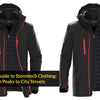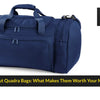Safety Boot Ratings Explained
- by Cathy Houghton
Definition
We take safety very seriously in the United Kingdom, but what do all those different safety boot ratings mean? It can be bewildering if you’ve never really looked into it before. However, never fear, at Active Workwear, we believe that our clients deserve to understand all safety boot standards and ratings.

This is why we’ve compiled this list of safety footwear ratings and gone on to explain what each one means.
The International Organization for Standardization originally defined the minimum safety boot standards that we'll cover here. When it comes to protective footgear in Europe, the standard is set at EN ISO 20345:2011.
There were a few updates to this standard, but the most important of which is that the toe area must protect the wearer against the impact of up to 200 joules. This essentially means that it must be strong enough to withstand common workplace accidents.
Any new products that are released and marketed as safety gear must adhere to this standard. Any products that were certified under the standard before the changes must undergo recertification under the stricter new standards.
Categories
The standards as laid out are as follows:
SB – The Basic Requirements
This is the minimal requirement for any safety gear. It needs to be able to resist the impact of up to 200 joules. Anything rated below this cannot be deemed to be certified safety gear.
S1 – The Basic requirements Along With
In addition to the basic requirement of the impact resistant toe area, the boot must also have:
- A heel area that is completely enclosed
- Good energy absorption properties in the seat area
- A resistance to fuel oil
- Antistatic protection
S1P – The S1 Requirements Along With
Moreover, the footwear must also be resistant to penetration. In other words, if you step on a nail, it shouldn’t go right through the boot.
S2 Requirements
In addition to the basic S1 requirements, the boot must not allow water penetration or absorption. Essentially, they should be water resistant at the very least.
S3 Requirements
- Resistance to penetration
- An outsole that is cleated to allow better traction and grip in wet conditions
S4 Requirements
- An upper that is completely moulded out of rubber or a polymer rendering it waterproof
S5 Requirements
- Penetration protection in the midsole area
Other Ratings to Be Aware Of
You’ll also usually find a rating like SRA or SRB on some gear. These mean that the footwear is slip resistant and that this resistance has been tested when it comes to the following codes. (The SR stands for Slip Resistant, and the letter appended to the end tells you the material it has been tested on.)
- SRA: This has been tested on a tiled ceramic floor that has been wet with a diluted soap solution
- SRB: This has been tested on a steel surface that has had glycerol poured onto it
- SRC: This incorporates both the A and B conditions, so it has been tested on slick steel and ceramic tiles
You might also see these additional symbols concerning ratings.
- A: Antistatic
- AN: Protects the ankles
- C: Conductive
- CR: The upper will resist cuts
- HRO: The outsole is resistant to hot temperatures
- I: Insulated against electricity
- M: Protects the metatarsals
- P: The sole is resistant to penetration
- WR: The shoes resist water — that’s not necessarily waterproof, though
- WRU: The shoes will not allow water to penetrate or water to be absorbed
The more safety features that are built into the shoes, and the more protection they provide, the more you can expect to pay. Review these safety boots ratings to choose the right safety gear for the job that you are doing.





